Freeze drying is a method of preservation that involves removing moisture from food to prevent the growth of bacteria and other microorganisms that cause spoilage. Freeze drying is a popular method of food preservation because it allows food to be stored for long periods of time without the need for refrigeration or other preservation methods.
Freeze dryers are machines that remove water from food or other materials by freezing them and then using a vacuum to sublimate the ice, leaving behind a dried product that can be stored for long periods of time.
Freeze dryers come in many different shapes and sizes, from small countertop units that are designed for home use to large industrial machines that are used in food production facilities.
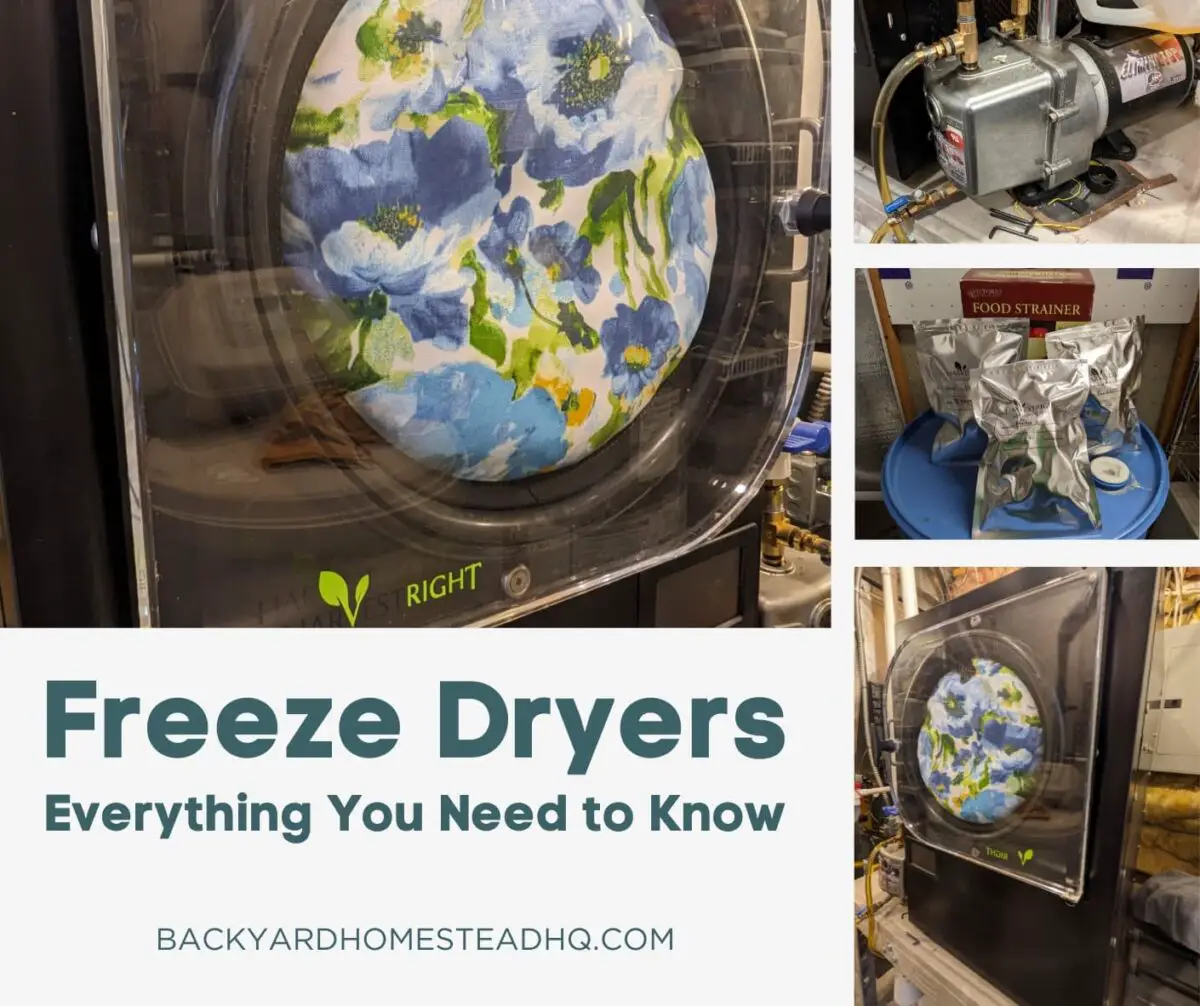
Table of Contents
Freeze Dryer Equipment and Accessories
There are three main parts to a freeze dryer:
- The freeze dryer,
- A vacuum pump,
- And a vacuum chamber.
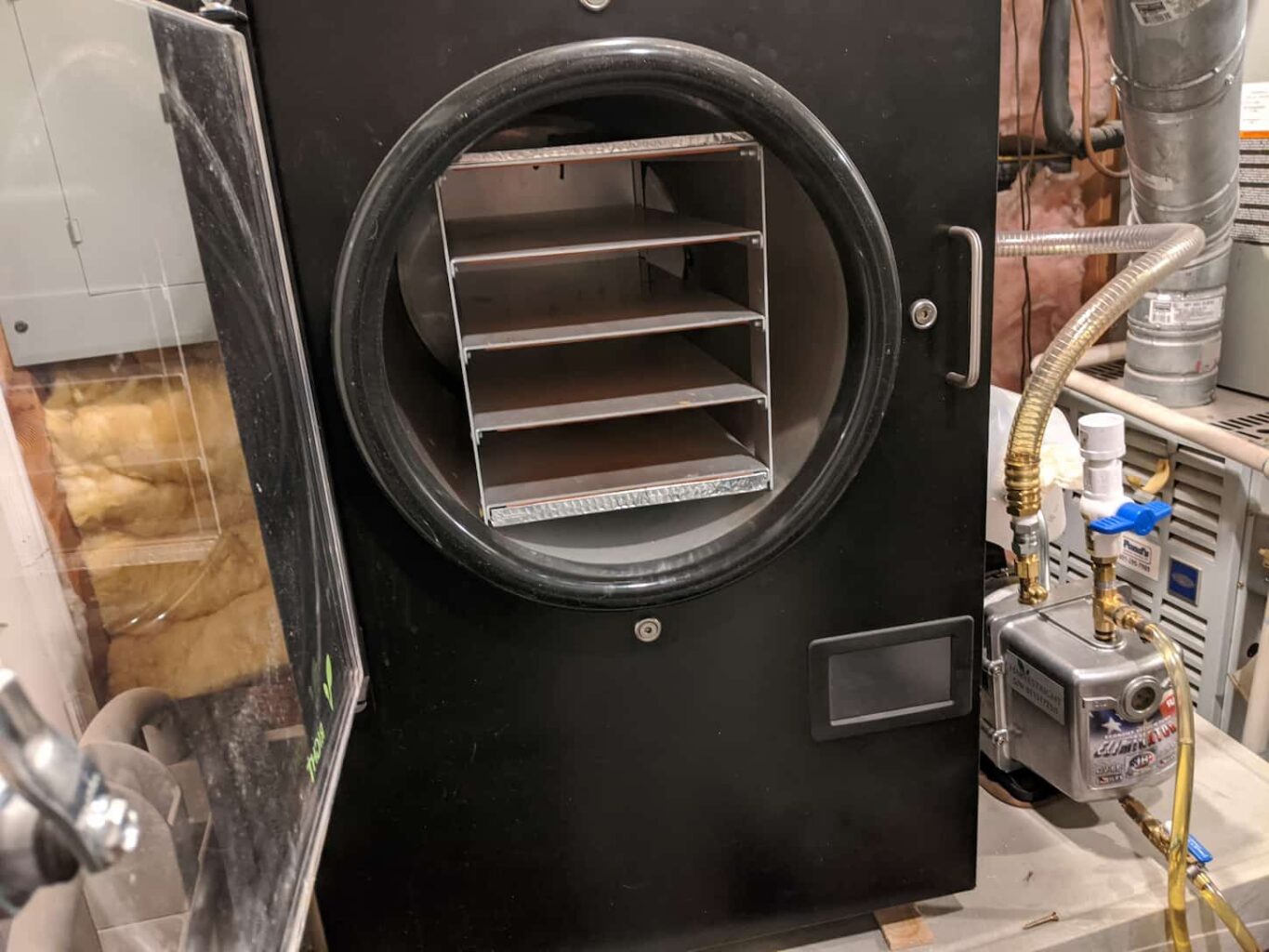
The Freeze Dryer
The freeze-dryer is the heart of the freeze-drying equipment and process. It is a specialized machine designed to remove moisture from a frozen sample through sublimation, preserving the sample’s integrity and extending its shelf life.
A key component of the freeze dryer is its cooling system, which maintains a low temperature during the process. Depending on the required functionality and scale, various freeze dryers are available in the market, ranging from small tabletop units to large industrial systems.
For home-based and cottage business types of freeze-drying, Harvest Right is the leading brand.
The Vacuum Pump
Next up is the vacuum pump. The vacuum pump plays a crucial role in freeze-drying by creating a low-pressure environment within the vacuum chamber. This enables the efficient removal of water molecules from the sample as they sublimate into the gas phase.
Two main types of vacuum pumps are used in freeze-drying: the oil pump and the oil-less pump. While a basic oil pump may be included with the purchase of a freeze dryer, oil-less pumps require less hands-on servicing and can be an additional expense when setting up your freeze-drying system.
You can also build a DIY automated filtration system for an oil-based vacuum pump using the instructions in my complete guide to vacuum pumps.
The Vacuum Chamber
Lastly, the vacuum chamber provides a controlled space where the freeze-drying process takes place. This chamber needs to be vacuum-tight and houses the sample holders or trays that hold the frozen samples during the process.
The vacuum chamber is essential to maintaining the proper conditions for sublimation to occur and ensuring an efficient and successful freeze-drying procedure. Different vacuum chambers are available depending on the scale and capacity required for the specific application.
Freeze Dryer Accessories
These are important accessories to have if you’re considering a freeze dryer unit.
- Stainless steel trays are ideal for freeze drying food as they do not react with the food. If you do a lot of freeze-drying, get a second (or even a third) set of trays.
- Mylar bags are the go-to storage method for freeze-dried food.
- Oxygen absorbers will help stored food last longest.
- An impulse sealer is how you seal Mylar bags.
- Vacuum sealers are a must if you plan to use mason jars.
- Silicone mats and silicone ice trays are a must for freeze-drying liquids or semi-liquid items.
If you get a Harvest Right unit, many of these accessories are included in your initial purchase. Depending on a sale, you may even get extra items. Be sure to see what current sales or options are in play.
Let’s put it all together to understand how a freeze dryer works.
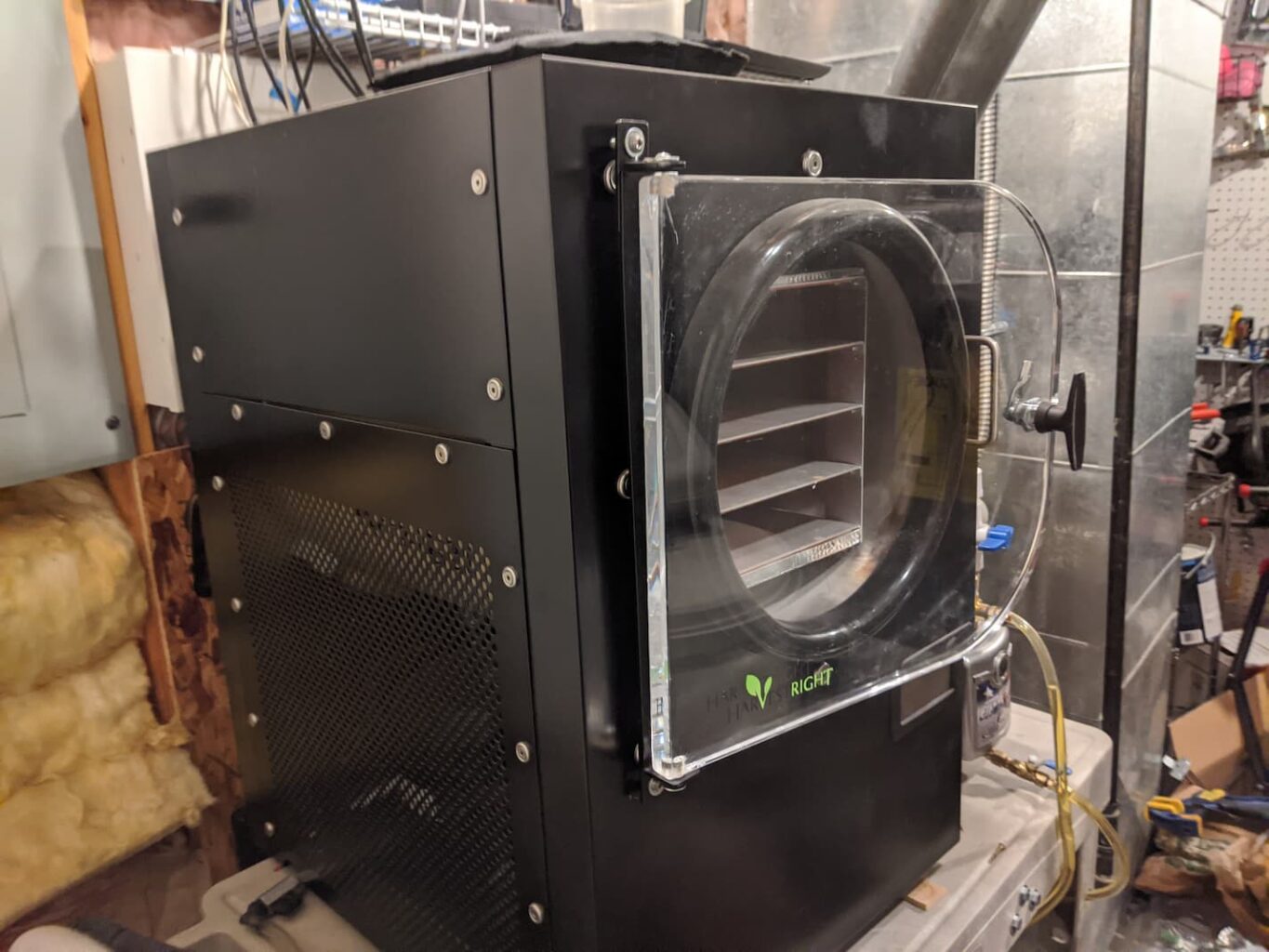
How Freeze Dryers Work
Freeze drying, also known as lyophilization, is a three-step process of freezing, primary drying (via a vacuum chamber to reduce the pressure, causing the ice to sublimate directly into vapor without transitioning to a liquid), and secondary drying with warming.
In a freeze dryer, food is frozen at temperatures below -30°F (-34°C) and then placed in a vacuum chamber where the water is removed through sublimation as the temperature is gradually raised.
Sublimation is a crucial aspect of freeze-drying. It ensures the ice can change directly from a solid to a vapor without passing through a liquid phase. This preserves the food’s structural integrity and nutritional content, retaining its color, shape, and taste even after the process is completed. Controlling the pressure and temperature during the process makes sublimation in freeze-drying possible.
- Freeze dryers are machines that are used to perform the freeze drying process and come in many different shapes and sizes.
- Freeze drying is a popular method of food preservation that involves removing moisture from food to prevent spoilage.
- Freeze drying allows food to be stored for long periods of time without the need for refrigeration or other preservation methods.
Running a Freeze Dryer: Things to know
It’s essential to know how to monitor and control the freeze-drying unit (including the vacuum chamber and pump) to properly freeze-dry items so they are safe for eating in the future.
- If you get a Harvest Right freeze-dryer, you can manage these primarily by watching the drying time and overall chamber temperature.
- If you build a DIY freeze-dryer, you must know these concepts backward and forward to complete the job.
- Other freeze dryer brands will have set controls and parameters to help you make sure everything’s working properly. Be sure to read and know the owner’s manual.
This is mostly general information; we’ll cover specifics for at-home freeze dryers later in this article.
Temperature and Pressure Control
When it comes to freeze drying, monitoring and controlling temperature and pressure are crucial for maintaining the quality of the final product. In my experience, measuring product temperature helps optimize the drying speed and saves the batch if any unexpected issues occur.
I always keep the product temperature below a specific threshold limit throughout the process. This is essential because exceeding this limit can damage the product structure.
While managing pressure levels is also essential, the freeze-drying process is highly sensitive to pressure variations. To ensure effective control, you can employ monitoring devices like thermocouples, comparative pressure measurement, condenser pressure, and vacuum shut-off valves. These tools are valuable in keeping pressure levels within the desired range, thus contributing to a successful freeze-drying process.
Identifying and Solving Issues
Despite our best efforts, there can be instances when unexpected problems arise during the freeze-drying process. To troubleshoot these issues, I pay close attention to important process parameters like the drying time and temperature.
One useful method I’ve learned is annealing, a controlled heating process that can help address any issues that may pop up during primary drying. Annealing optimizes the drying time by improving the ice crystal structure, which enhances the sublimation rate.
Monitoring the freeze-drying process closely enables me to identify potential issues and quickly take corrective action, ensuring the batch integrity and maintaining the quality of my precious freeze-dried products.
If you need help solving software issues, read our article: Harvest Right Freeze Dryer Software: A Complete Guide.
Types of Freeze Dryers
When it comes to freeze dryers, there are several types available on the market. Each type has its own unique features and is designed for specific purposes.
In this section, we will discuss the different types of freeze dryers available.
Home Freeze Dryers
Home freeze dryers, as the name suggests, are designed for home use. They are compact, relatively portable, and easy to use. These machines are perfect for preserving food, leftovers, and even flowers.
They typically have a lower batch capacity than commercial units, but large enough for most families. Home freeze dryers are affordable and can usually be operated using a standard 110-volt outlet, though some require a dedicated 20-amp circuit.
The Harvest Right Small Home Freeze Dryer is a popular choice for home use, though we recommend the medium.
Commercial Freeze Dryers (Large Units)
Commercial freeze dryers are designed for heavier use. They are typically used in food processing plants or other industrial settings. Commercial freeze dryers are capable of handling large quantities of food or other materials and can be operated continuously.
Large or commercial freeze dryers typically have a batch capacity of up to 2,000 pounds and can freeze dry up to 10,000 pounds of food per year. They require a dedicated 220-volt outlet and can be quite expensive.
For smaller commercial ventures, especially cottage businesses, a Harvest Right large or X-large unit may be appropriate.
Industrial Freeze Dryers
Industrial freeze dryers are designed for heavy-duty use in industrial settings. They are capable of handling large quantities of food or other materials and can be operated continuously.
Industrial freeze dryers are the largest and most expensive type of freeze dryer (excepting the pharmaceutical version). They require a dedicated 220-volt outlet and can be quite complex to operate. They are typically used in large-scale food processing plants or other industrial settings.
Pharmaceutical Freeze Dryers
Pharmaceutical freeze dryers are designed specifically for the pharmaceutical industry. They are used to preserve and dry pharmaceutical products such as vaccines, antibiotics, and other medications. These machines are highly specialized and are designed to meet strict regulatory requirements.
Pharmaceutical freeze dryers are the most expensive type of freeze dryer and require a dedicated outlet. They are typically used in pharmaceutical manufacturing plants.
Using a Freeze Dryer at Home
Freeze drying is a great way to preserve food for long-term storage. With a home freeze dryer, you can easily freeze dry a variety of foods, including fruits, vegetables, meats, and even entire meals.
In this section, we’ll cover the basics of using a freeze dryer at home.
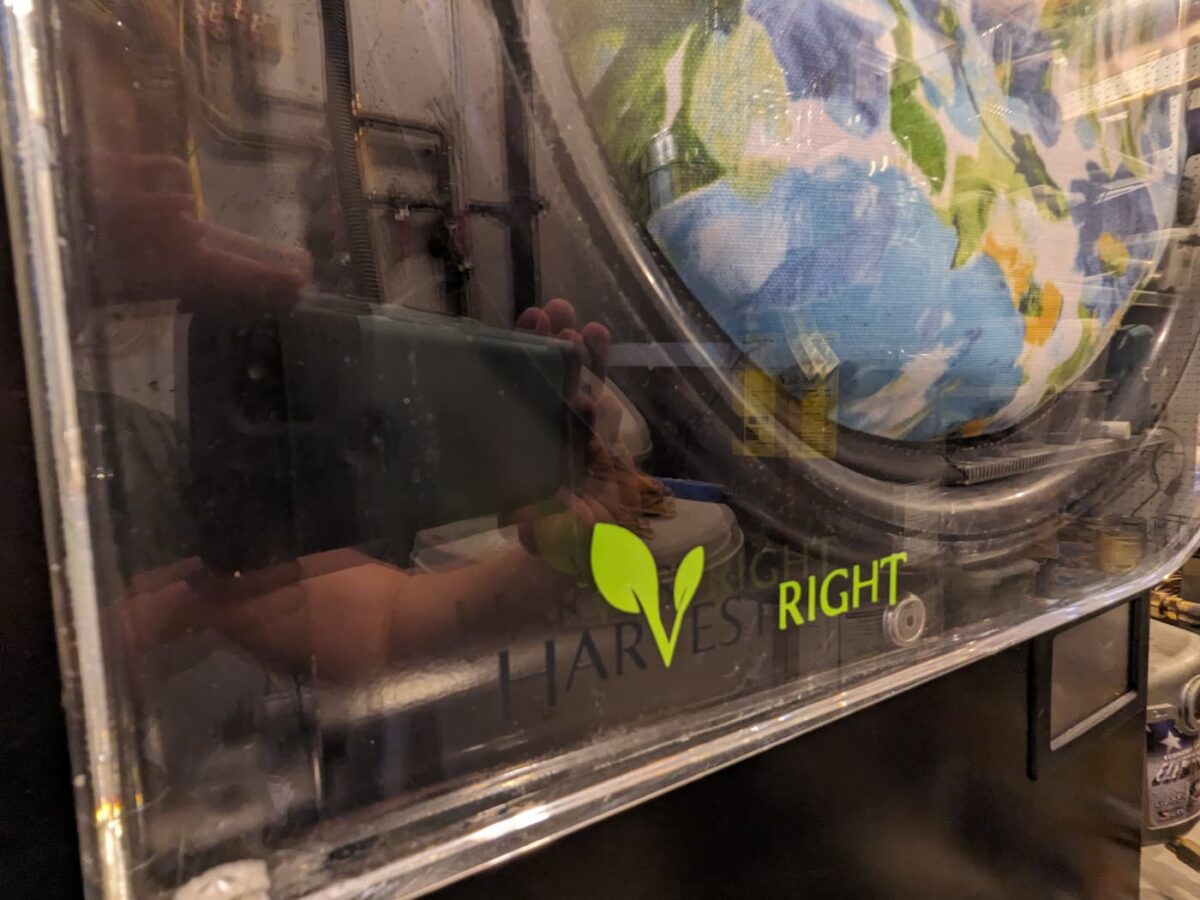
Space Requirements
Before you buy a home freeze dryer, it’s important to consider the space and spacing requirements. A typical home freeze dryer is about the size of two large microwaves stacked one on top of the other, and it will require a dedicated counter space with good airflow.
If you get a small or medium-sized Harvest Right unit, a standard plug will power your freeze dryer unit. If you get a large or extra-large unit, you’ll need to make sure you have access to a dedicated 20-amp circuit.
Location Requirements
A freeze-dryer, like any other appliance, works best in a certain temperature range. It will, therefore, work best if kept indoors in a regulated, temperature-controlled room. The area should also have good airflow to help it run properly.
Here are some great examples of where to store and use a freeze-dryer: in a room of your home dedicated to food storage; on a cart that can be pulled out of a closet when in use; in a temperature-controlled shop.
Here are some less-than-ideal examples of where to store and use a freeze-dryer: in a shed; in an outdoor garage; or under a covered patio.
Read more about Where Should You Put a Freeze-Dryer? in our article here.
Operating a Home Freeze Dryer
Once you have your freeze dryer set up, the process of freeze drying food is relatively simple. Here are the basic steps:
- Prepare your food for freeze drying. This may involve blanching vegetables, slicing fruits, or cooking meats.
- Load the food into the freeze dryer trays. Be sure to arrange the food in a single layer, and leave some space between each piece.
- Close the freeze dryer door and turn on the unit. The freeze dryer will begin to remove moisture from the food.
- Once the freeze drying cycle is complete, remove the trays from the freeze dryer. The food should be dry and crispy.
- Store the freeze dried food in an airtight container or vacuum-sealed bag. Be sure to label the container with the type of food and the date it was freeze dried.
It’s important to note that the freeze drying process can take anywhere from 24 to 48 hours, depending on the type of food and the amount of moisture it contains. You’ll also want to make sure you follow the manufacturer’s instructions for your specific freeze dryer model.
Overall, a home freeze dryer is a great investment for anyone who wants to preserve food for long-term storage. With a little bit of practice, you’ll be able to freeze dry a variety of foods with ease.
Safety Measures
When freeze-drying food, it is important to follow proper safety measures to ensure that the food is safe to eat. This includes properly cleaning and sanitizing all equipment before use, using only high-quality ingredients, and properly storing the finished product in airtight containers.
Additionally, it is important to properly label all containers with the date of freeze-drying to ensure that the food is used within a reasonable amount of time.
Overall, freeze drying is an excellent food preservation method that can help you create long-lasting emergency food supplies or preserve perishable foods for later use.
By following proper safety measures and using high-quality ingredients, you can ensure that your freeze-dried food is safe to eat and retains most of its flavor and nutritional value.
Packaging Options for Freeze-Dried Goods
When it comes to preparing and packaging freeze-dried foods, there are a few things to keep in mind to ensure the longevity and quality of your food. Here are some tips to help you get started.
Sealing and Storing Food
No matter what type of container you use, it is important to properly seal and store your freeze-dried food. Here are some tips to keep in mind:
- Store your food in a cool, dry, and dark place.
- Avoid storing your food in areas with high humidity or temperature fluctuations.
- Label each container with the date and contents to help keep track of what you have stored.
Mylar Bags
Mylar bags are a popular choice for storing freeze-dried foods. They are durable, puncture-resistant, and help to keep out moisture and oxygen. Here are some tips for using mylar bags:
- Use bags that are specifically designed for food storage.
- Add an oxygen absorber to each bag to help remove any remaining oxygen.
- Seal the bag using an impulse sealer or a vacuum sealer.
Mason Jars
Mason jars are another option for storing freeze-dried foods. They are easy to find, inexpensive, and reusable. Here are some tips for using mason jars:
- Use jars that are specifically designed for canning or food storage.
- Add an oxygen absorber to each jar to help remove any remaining oxygen.
- Seal the jar using an impulse sealer or a vacuum sealer.
Impulse Sealers
An impulse sealer is a small appliance or device that uses heat to seal bags or other types of packaging. It is a useful tool for sealing mylar bags or other types of food storage containers. Here are some tips for using an impact sealer:
- Use bags or containers that are specifically designed for use with an impact sealer.
- Make sure the sealer is heated to the appropriate temperature before use.
- Use a steady, even pressure when sealing the bag or container.
Impulse sealers are also sometimes called heat or impact sealers.
Impulse Sealer
A highly recommended accessory for freeze-drying and food storage, as it’s how you seal mylar bags. Sometimes also called a heat or impact sealer.


If you click a link and make a purchase, we earn a commission at no additional cost to you. Full disclaimer information is in our terms and conditions.
Vacuum Sealers
A vacuum sealer is another option for sealing freeze-dried food, especially if you’re using mason jars. It works by removing the air from the bag or container before sealing it. Here are some tips for using a vacuum sealer:
- Use bags or containers that are specifically designed for use with a vacuum sealer.
- Make sure the sealer is set to the appropriate setting for the type of food you are sealing.
- Use a steady, even pressure when sealing the bag or container.
Overall, proper packaging and storage are key to ensuring the longevity and quality of your freeze-dried food. By following these tips, you can help ensure that your food stays fresh and delicious for years to come.
Choosing the Best Freeze Dryers for Home Use
When it comes to choosing the best freeze dryer, there are several factors to consider. In this section, we will discuss the key factors you need to consider when selecting the best freeze dryer for your needs.
When choosing the best freeze dryer for your needs, it is important to consider the capacity, size, finishes, and materials used in the construction of the freeze dryer. By assessing these factors, you can select the best freeze dryer that meets your specific needs.
Freeze Dryer Cost
Harvest Right home freeze dryers can cost anywhere from about $2,000 to $5,000, depending on the size and any sales or specials. Other brands of freeze dryers typically cost more than Harvest Right units, but they’re also a lot larger with a lot larger capacity.
Why are freeze dryers so expensive? It depends on the unit, its needs, and what it can do.
- Home freeze dryers usually are the least expensive, but they still run anywhere from $2,000 to $5,000 or more, depending on the size and added features.
- Commercial units can run anywhere from $5,000 to $100,000 or more, depending on the size and capacity.
- Industrial units are huge, and so they’re expensive.
- Pharmaceutical units are expensive because they have to be precise – and they likely need a lot of liability or other insurance.
Here’s a comparison of the four Harvest Right sizes, along with their prices and some other important factors when you’re pricing out the right option for your family.

Small Pro
from $2,695
Rating: ⭐⭐⭐⭐⭐ 4.6
Best for small families
More Details
- 4 Trays
- 6-10 pounds of food per batch
- Best for small families of 1-4 people
- Add $1,495 to upgrade to oil-free pump


Medium Pro
from $3,195
Rating: ⭐⭐⭐⭐⭐ 4.9
Best for most families
More Details
- 5 Trays
- 10-15 pounds of food per batch
- Best for most families
- Add $1,495 to upgrade to oil-free pump

Large Pro
from $3,795
Rating: ⭐⭐⭐⭐⭐ 4.7
Best for food storage pros
More Details
- 6 Trays
- 18-27 pounds of food per batch
- Best for large families or food storage pros
- Add $1,495 to upgrade to an oil-free pump
- Requires a dedicated 20-amp circuit

X-Large Pro
from $5,295
Rating: ⭐⭐⭐⭐⭐ 4.8
Best for food businesses
More Details
- 7 Trays
- 40-50 pounds of food per batch
- Best for large families or cottage businesses
- Comes with XL Premier Industrial Pump
- Add $1,695 to upgrade to an XL oil-free pump
- Requires a dedicated 20-amp circuit
If you click a link and make a purchase, we earn a commission at no additional cost to you. Full disclaimer information is in our terms and conditions.
Assessing Capacity
The first factor to consider when choosing the best freeze dryer is the capacity. The capacity of a freeze dryer refers to the amount of food it can process at a time.
- If you have a large family or plan to use the freeze dryer for commercial purposes, you will need a larger capacity freeze dryer.
- On the other hand, if you only plan to use the freeze dryer occasionally or for personal use, a smaller capacity freeze dryer may be sufficient.
Assessing Size
Another factor to consider when choosing the best freeze dryer is the size. The size of the freeze dryer will depend on the available space you have. If you have limited space, you may need to choose a smaller freeze dryer.
However, if you have ample space, you can opt for a larger freeze dryer.
Freeze-Dryer Accessories
Most Harvest Right freeze dryer units come with standardized accessories so that you can get to freeze-drying right away. If your package doesn’t include these things, make sure you purchase them separately.
- Stainless steel trays are also ideal for freeze drying food as they do not react with the food. If you do a lot of freeze-drying, get a second (or even a third) set.
- Mylar bags are the go-to storage method for freeze-dried food.
- Oxygen absorbers will help stored food last longest.
- An impulse sealer is how you seal Mylar bags.
- Vacuum sealers are a must if you plan to use mason jars.
- Silicone mats and silicone ice trays are a must for freeze-drying liquids or semi-liquid items.
Our Recommendation For Most Cases: Medium
In most cases, a medium-sized Harvest Right freeze-dryer unit is the best choice; it handles the biggest capacity of food while being able to use a standard plug without needing a dedicated 20-amp circuit.
Harvest Right Medium Pro Freeze Dryer
Best for most families
- 5 Trays
- 10-15 pounds of food per batch
- Best for most families
- Add $1,495 to upgrade to oil-free pump

If you click a link and make a purchase, we earn a commission at no additional cost to you. Full disclaimer information is in our terms and conditions.
Considering Finishes and Materials
The finishes and materials used in the construction of a freeze dryer are also important factors to consider. A freeze dryer made of stainless steel is durable and easy to clean.
Freeze dryers with a powder-coated finish are resistant to scratches and dents.
Look at what color options are available, and see if the price change is worth the color you want. We got the black unit because, at the time, we didn’t want to pay an extra $500 for the stainless steel color.
Vacuum Pumps
When it comes to freeze-drying, vacuum pumps play a crucial role in the entire process. These pumps are used to extract water vapor from the freeze dryer, and without them, your freeze dryer won’t work at all. In this section, we’ll take a closer look at the role of vacuum pumps in freeze drying.
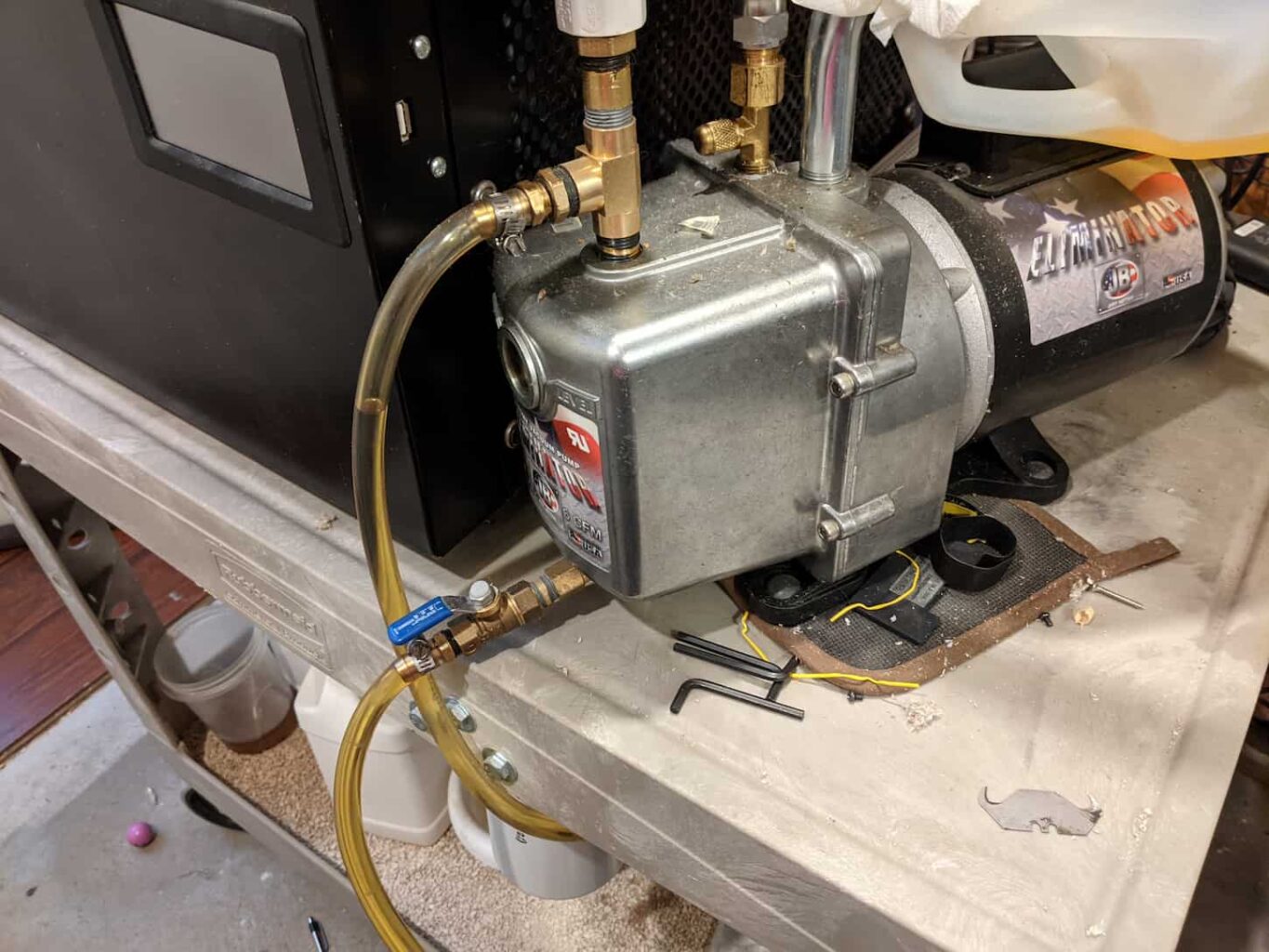
How do vacuum pumps work in freeze drying?
During the freeze-drying process, vacuum pumps are used to create a low-pressure environment inside the freeze dryer chamber. This low-pressure environment is necessary to remove the water from the food or other material being dried.
The vacuum pump works by removing the air and other gases from the chamber, creating a vacuum that allows the water to evaporate at a lower temperature than it would under normal atmospheric pressure.
Types of vacuum pumps used in freeze drying
There are two main types of vacuum pumps used in freeze drying: oil-free pumps and oil-sealed pumps.
- Oil-free pumps are more expensive but are more environmentally friendly and require less maintenance.
- Oil-sealed pumps are less expensive but require regular oil changes and maintenance.
Upgrading to an oil-free pump usually costs about $1,500. If that price jump is too steep, build a DIY oil filtration system like ours to minimize the work you need to do to keep your unit up and running.
Factors to consider when choosing a vacuum pump
When choosing a vacuum pump for your freeze dryer, there are several factors to consider. These include the size of the freeze dryer, the type of material being dried, the desired level of vacuum, and the cost of the pump.
It’s important to choose a pump that is powerful enough to create the necessary vacuum but not so powerful that it damages the material being dried.
Important note: some freeze dryers only have one vacuum pump choice due to the size of the unit. Swapping for another vacuum pump isn’t recommended unless it fits the required specifications for the unit.
Maintenance and care of vacuum pumps
Proper maintenance and care of your vacuum pump are essential to ensure its longevity and effectiveness. Regular oil changes and cleaning are necessary for oil-sealed pumps, while oil-free pumps require less maintenance but still need to be cleaned and inspected regularly.
It’s also important to follow the manufacturer’s recommendations for maintenance and care to ensure that your vacuum pump performs optimally. Vacuum pumps play a vital role in the freeze-drying process, and choosing the right pump for your freeze dryer is essential to achieving the best results.
By understanding the different types of vacuum pumps, the factors to consider when choosing a pump, and the importance of proper maintenance and care, you can ensure that your freeze dryer operates efficiently and effectively.
Freeze Dryers VS Other Food Storage Devices
Freeze dryers differ from other food preservation appliances in several ways.
- Unlike freezers, which only preserve food for a limited time, freeze-drying can extend shelf life for years while retaining the food’s original flavor and nutrients.
- Dehydrators use heat to remove moisture, but freeze-drying is a gentler process that preserves the food’s structure and texture.
- Canning equipment uses heat to sterilize food, but freeze-drying preserves the food without the need for high temperatures or preservatives.
- However, freeze-drying equipment can be more expensive and the process can be more time-consuming than other methods, even if it is fairly hands-off.
Frequently Asked Questions
Frequently Asked Questions
We’re here to help! Check out our FAQs section below for answers to common questions. If we missed yours, let us know, and we’ll update the article. Contact us through our website, and we’ll respond directly to your question.
How much do freeze dryers cost?
The cost of freeze dryers varies depending on the size, capacity, and features of the unit. Home freeze dryers can cost anywhere from $1,800 to $5,000, while commercial freeze dryers can cost tens of thousands of dollars.
What are the maintenance requirements for freeze dryers?
Freeze dryers require regular maintenance to ensure that they continue to function correctly, most often to the vacuum pump. Maintenance tasks include cleaning the unit, replacing vacuum pump oil, and checking the seals and gaskets. Most manufacturers provide detailed instructions on how to maintain their freeze dryers.
Are freeze dryers worth it?
The value of a freeze dryer depends on individual needs and budget. While they can be expensive, they are cost-effective for preserving large quantities of food or materials for an extended time. Freeze-drying preserves flavor, texture, and nutrients, making it a popular choice for food preservation.
What can I use instead of a freeze dryer?
Dehydrators can be a good alternative to freeze dryers. They don’t remove as much moisture as freeze dryers, but they extend the shelf life of food by removing a significant amount of moisture. Other alternatives to freeze dryers include canning, pickling, and fermenting, but these methods may not preserve the food for as long as freeze-drying.
